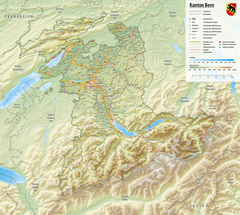Untertorbrücke
| Untertorbrücke | |
|---|---|

The Untertorbrücke as seen from the Nydeggbrücke
|
|
| Coordinates | 46°56′57.96″N 7°27′30.47″E / 46.9494333°N 7.4584639°ECoordinates: 46°56′57.96″N 7°27′30.47″E / 46.9494333°N 7.4584639°E |
| Carries | Two lanes and sidewalks |
| Crosses | Aare |
| Locale | Bern, Switzerland |
| Characteristics | |
| Design | Arched lintel bridge |
| Material | Natural stone (Sandstone, tuff) |
| Total length | 52.5 meters (172 ft) |
| Width | 7.5 meters (25 ft) |
| Height | 8.1 meters (27 ft) |
| Longest span | 15.1 meters (50 ft) |
| No. of spans | 3 |
| Piers in water | 2 |
| Clearance below | 4.3 meters (14 ft) |
| History | |
| Construction start | 1461 |
| Construction end | 1489 |
The Untertorbrücke (German: Lower Gate Bridge) is a stone arch bridge that spans the Aare at the easternmost point of the Enge peninsula in the city of Bern, Switzerland, connecting the Mattequartier in the Old City to the Schosshalde neighbourhood. Built in its current form in 1461–89, it is the oldest of Bern's Aare bridges, and was the city's only bridge up until the middle of the 19th century. It is a Swiss heritage site of national significance.
The need for a river crossing became urgent soon after the founding of Bern in 1191. The young city-state's first attempt at building a wooden bridge over the Aare triggered a war with Count Hartmann of the powerful House of Kyburg that controlled the territory east of the Aare. Thanks to a peace mediated by Savoy, the first Untertorbrücke could be completed in 1256. In 1288, it survived a heavy attack during King Rudolph of Habsburg's second siege of Bern.
The bridge was built from oak wood and is believed to have been at least partially covered. It was protected by a fortified tower to the east, carried a guard house in its center and may also have been built over with other houses or shacks.
A 1460 flood of the Aare caused severe damage to the bridge, and the city government decided to rebuild it in stone, requesting the services of a work master from Zürich who had then recently completed a bridge over the Limmat in Baden. The piers appear to have been complete and the bridge largely usable by March 1467, when the bridge chapel was consecrated. The construction was then halted because of massive cost overruns and intermittent wars. It resumed in 1484–87 with the completion of the fortifications, the bridgehead drawbridge and the access roads.
...
Wikipedia



